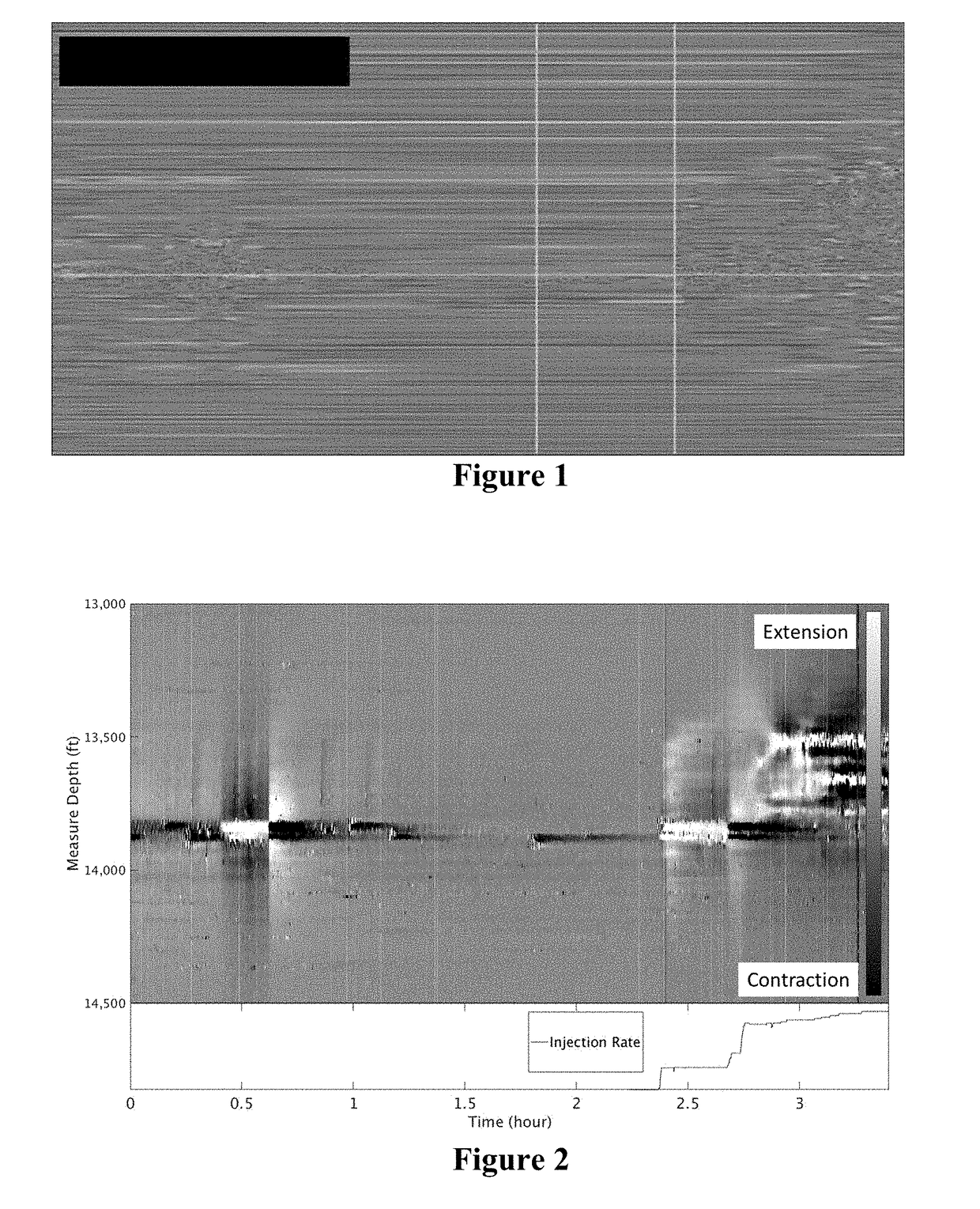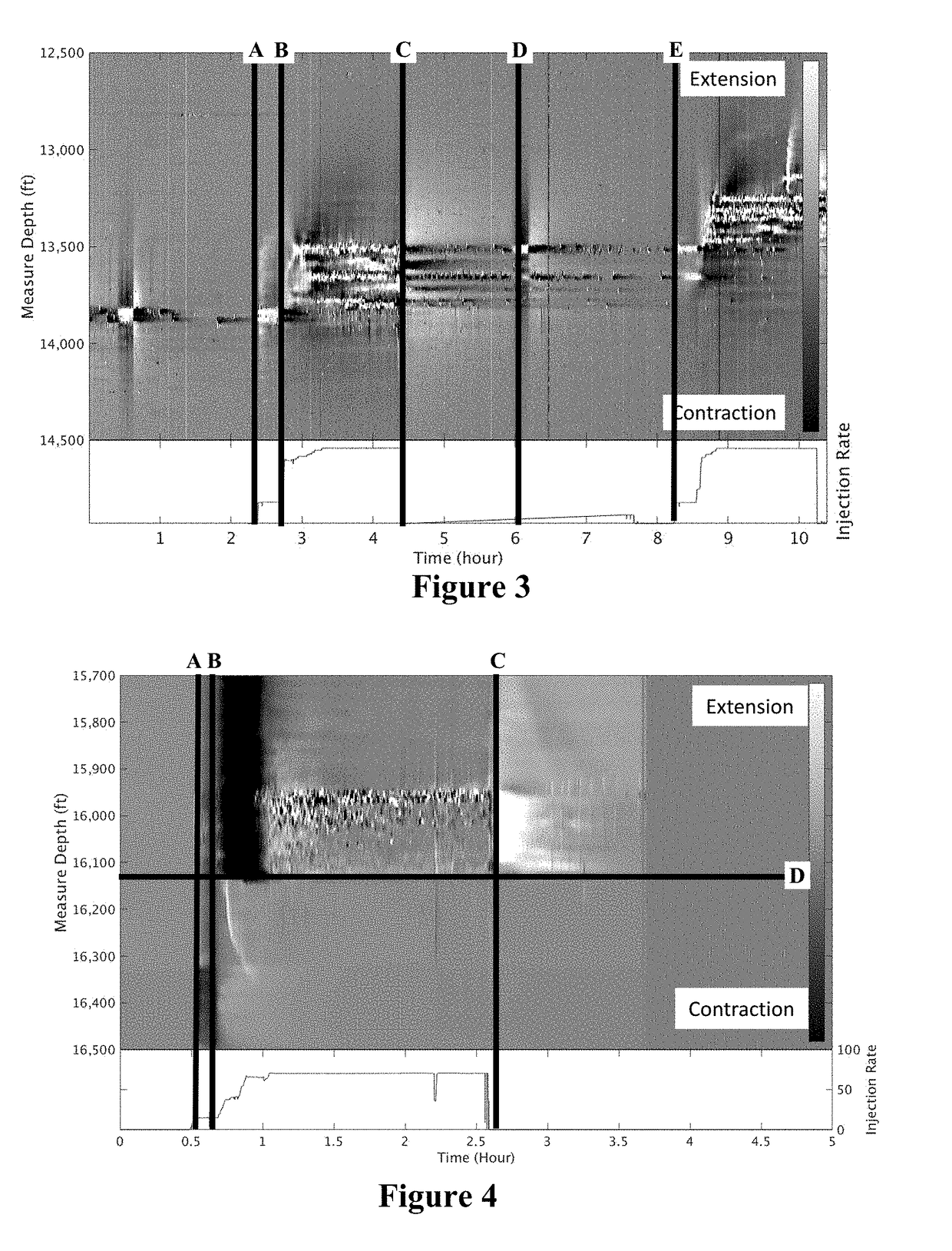Low frequency distributed acoustic sensing
a distributed acoustic sensing and low frequency technology, applied in the field of distributed fiber optic sensing, can solve the problems of many vendors removing lower frequency and ultra-low frequency signals from data, and achieve the effect of improving hydrocarbon production
- Summary
- Abstract
- Description
- Claims
- Application Information
AI Technical Summary
Benefits of technology
Problems solved by technology
Method used
Image
Examples
example 1
In-Well Signal During Injection
[0053]In example 1, fiber-optic cables are installed outside of the casing and cemented in place along the length of the well during a procedure, in this case during a stage of fracturing. Numerous interrogators are available to record optical signals. In one embodiment, Pinnacle Gen-1 Phase-1 interrogators are used for the recording. The fiber optic cables are interrogated with multiple high-speed laser pulses while monitoring the reflected light signal (Rayleigh scatter) along the fiber. This is repeated in a variety of patterns dependent upon the data being collected. The raw data are sampled at 10 kHz continuously at more than 6000 locations (referred as “channels” in this study) with 1 m spatial separation along the fiber. The gauge length is set to 5 m. When recording, the measured optical phase is differentiated in time, so the raw DAS data is linearly associated with strain rate along the fiber.
[0054]FIG. 4 shows a Low-Frequency In-well signal....
example 2
Cross-Well Signal During Hydraulic Fracturing
[0056]In example 2, fiber-optic cables are installed outside of the casing and cemented in place along the length of an adjacent well. Numerous interrogators are available to record optical signals. In one embodiment, Pinnacle Gen-1 Phase-1 interrogators are used for the recording. The fiber optic cables are interrogated with multiple high-speed laser pulses while monitoring the reflected light signal (Rayleigh scatter) along the fiber. This is repeated in a variety of patterns dependent upon the data being collected. The raw data are sampled at 10 kHz continuously at more than 6000 locations (referred as “channels” in this study) with 1 m spatial separation along the fiber. The gauge length is set to 5 m. When recording, the measured optical phase is differentiated in time, so the raw DAS data is linearly associated with strain rate along the fiber.
[0057]FIG. 3 shows a Low-Frequency Cross-well signal. This data is obtained from an observ...
example 3
In-Well Signal During Production
[0059]The production well with optical fiber installed is shut in for a period of time. During the shut-in period, small differences in formation temperature permeate into the well bore through thermal conduction. When production resumes, the fluid flow within the well causes a measurable wave of temperature fluctuations to move in the direction of the flow. Flow rates along the well can be inferred from these temperature changes, and variations in rates provides an indication of the relative productivity of the well intervals.
PUM
 Login to View More
Login to View More Abstract
Description
Claims
Application Information
 Login to View More
Login to View More - R&D
- Intellectual Property
- Life Sciences
- Materials
- Tech Scout
- Unparalleled Data Quality
- Higher Quality Content
- 60% Fewer Hallucinations
Browse by: Latest US Patents, China's latest patents, Technical Efficacy Thesaurus, Application Domain, Technology Topic, Popular Technical Reports.
© 2025 PatSnap. All rights reserved.Legal|Privacy policy|Modern Slavery Act Transparency Statement|Sitemap|About US| Contact US: help@patsnap.com


